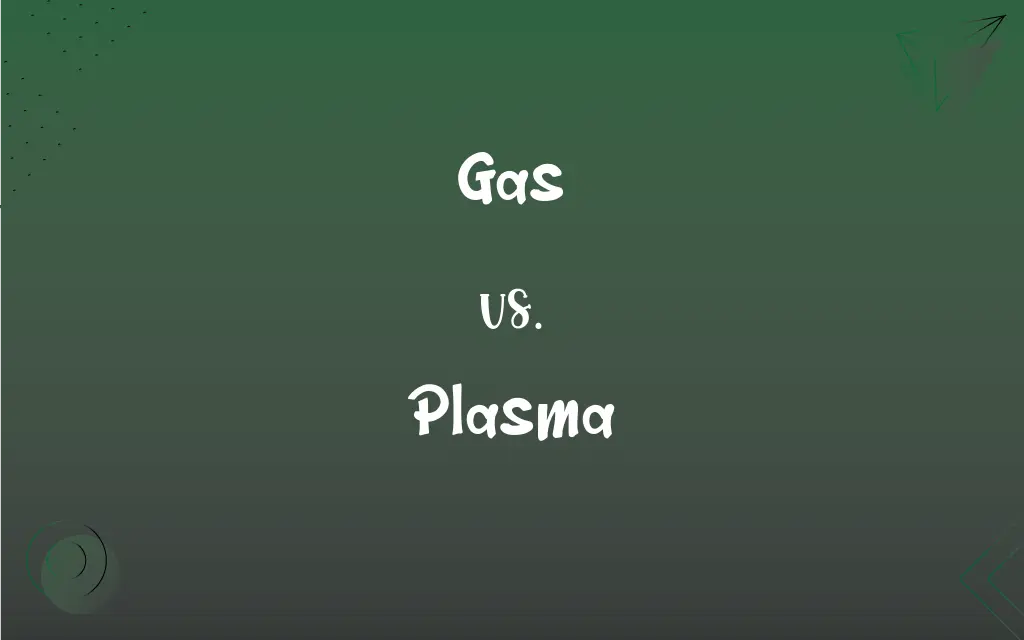Gas vs. Plasma: What's the Difference?
Edited by Harlon Moss || By Janet White || Published on December 1, 2023
Gas is a state of matter where particles are free-moving and not bound to each other. Plasma is a state of matter similar to gas but with ionized particles, containing free electrons and ions.

Key Differences
Gas is one of the fundamental states of matter, characterized by free-moving particles that fill their container. It lacks a fixed shape and volume, taking the shape and volume of its container. Plasma, while similar to gas in that it does not have a fixed shape or volume, is a distinct state of matter where the gas phase is energized until atomic electrons are no longer associated with any particular atomic nucleus.
Particles in a gas move independently and are not ionized, meaning they retain their electronic structure. Gases are found naturally on Earth and are a major part of the atmosphere. In contrast, plasma consists of a mixture of free electrons and ions – atoms that have lost or gained electrons – and is often referred to as an ionized gas. Plasma is commonly found in stars, including the sun.
In gas, the interaction between particles is minimal and usually occurs through collisions, which can be elastic. The behavior of gases is often described by the kinetic theory of gases. Plasma, however, has particles that are electrically charged and therefore, besides collisions, they interact through electromagnetic forces, which can significantly alter their behavior compared to a neutral gas.
Gas can be converted into a plasma through processes like heating or applying a strong electromagnetic field, which provides enough energy for ionization. The creation of plasma involves the breaking of atomic bonds, resulting in free electrons. Plasma is unique in its ability to conduct electricity and respond to magnetic fields, properties that gases do not possess.
Gas is commonly used in everyday life in various forms, such as in heating, cooking, and as a chemical reactant. It is a critical component of Earth's atmosphere, essential for life. Plasma, while less common in everyday experiences, plays a crucial role in advanced technology, such as in plasma screens, industrial processes, and in understanding astrophysical phenomena.
ADVERTISEMENT
Comparison Chart
Particle Composition
Consists of unbound, non-ionized particles.
Consists of ionized particles including free electrons and ions.
Electrical Conductivity
Does not conduct electricity.
Conducts electricity due to the presence of charged particles.
Natural Occurrence
Commonly found in Earth's atmosphere.
Rare on Earth, more common in stars and interstellar space.
Interaction Forces
Particles interact mainly through collisions.
Particles interact through both collisions and electromagnetic forces.
Response to Fields
Not responsive to magnetic or electric fields.
Responsive to magnetic and electric fields due to charged particles.
ADVERTISEMENT
Gas and Plasma Definitions
Gas
A state of matter with free-moving particles that occupy the volume of their container.
Oxygen gas is essential for human respiration.
Plasma
A collection of charged particles that responds uniquely to electromagnetic fields.
Auroras are natural displays of plasma in Earth's upper atmosphere.
Gas
Particles that are far apart and move randomly, often used as fuel.
Natural gas is commonly used for cooking and heating.
Plasma
An ionized gas consisting of free electrons and ions, often found in stars.
The sun is composed primarily of plasma.
Gas
A fluid state of matter that does not have a fixed shape but has a variable volume.
Helium gas is lighter than air and is used to fill balloons.
Plasma
A state of matter similar to gas but with charged particles, capable of conducting electricity.
Plasma is used in neon signs to create glowing effects.
Gas
A state of matter without a fixed shape, composed of molecules in constant random motion.
Carbon dioxide gas is released during the process of combustion.
Plasma
Gas-like, electrically conductive fluid composed of ionized particles.
In plasma TVs, electrically charged plasma emits light to form images.
Gas
Air-like fluid substance which expands freely to fill any space available.
The gas in the atmosphere provides the necessary pressure for breathing.
Plasma
The fourth state of matter, distinct from solid, liquid, or gas, with unique electromagnetic properties.
Researchers study plasma for advanced fusion energy research.
Gas
The state of matter distinguished from the solid and liquid states by relatively low density and viscosity, relatively great expansion and contraction with changes in pressure and temperature, the ability to diffuse readily, and the spontaneous tendency to become distributed uniformly throughout any container.
Plasma
The clear, yellowish fluid portion of blood, lymph, or intramuscular fluid in which cells are suspended. It differs from serum in that it contains fibrin and other soluble clotting elements.
Gas
A substance in the gaseous state.
FAQs
How is gas different from plasma?
Gas particles are not ionized and don't conduct electricity, while plasma particles are ionized and conduct electricity.
What is plasma?
Plasma is a state of matter similar to gas but with ionized particles that are electrically charged.
Can gas be transformed into plasma?
Yes, gas can be transformed into plasma by adding energy to ionize the particles.
What are common uses of gas?
Common uses of gas include fuel for heating and cooking, and as a reactant in industrial processes.
What is gas?
Gas is a state of matter where particles are spread out, move freely, and take the shape and volume of their container.
Is air a gas or plasma?
Air is a mixture of gases, primarily nitrogen and oxygen, and is not a plasma under normal conditions.
Where is plasma found?
Plasma is commonly found in stars, lightning, neon signs, and plasma TVs.
How do plasma TVs work?
Plasma TVs work by using electrically charged ionized gases that emit light to form images.
Do both gas and plasma have a definite shape?
No, neither gas nor plasma has a definite shape; they both take the shape of their container.
How does plasma conduct electricity?
Plasma conducts electricity due to the presence of free electrons and ions that carry electrical currents.
Can plasma exist in room temperature conditions?
Plasma generally requires high temperatures or electrical energy to form and is not typically found at room temperature.
Can gas be compressed?
Yes, gases can be compressed because of the space between particles.
What are the properties of gas?
Gases have variable shapes and volumes, low density, and particles that move freely.
Are all gases flammable?
Not all gases are flammable; flammability depends on the chemical properties of the gas.
What role does plasma play in the universe?
Plasma is the most abundant form of visible matter in the universe, present in stars and interstellar space.
What are the uses of plasma in technology?
Plasma is used in technologies like plasma cutting, plasma screens, and in scientific research.
How does pressure affect gas?
Increasing pressure on a gas decreases its volume, according to Boyle’s law.
Why is plasma considered the fourth state of matter?
Plasma is considered the fourth state of matter due to its unique properties, different from solids, liquids, and gases.
What happens when gas is heated?
When gas is heated, its particles move faster and the gas expands.
Is plasma visible to the naked eye?
Plasma can be visible, as in the case of neon lights or auroras.
About Author
Written by
Janet WhiteJanet White has been an esteemed writer and blogger for Difference Wiki. Holding a Master's degree in Science and Medical Journalism from the prestigious Boston University, she has consistently demonstrated her expertise and passion for her field. When she's not immersed in her work, Janet relishes her time exercising, delving into a good book, and cherishing moments with friends and family.
Edited by
Harlon MossHarlon is a seasoned quality moderator and accomplished content writer for Difference Wiki. An alumnus of the prestigious University of California, he earned his degree in Computer Science. Leveraging his academic background, Harlon brings a meticulous and informed perspective to his work, ensuring content accuracy and excellence.






































































